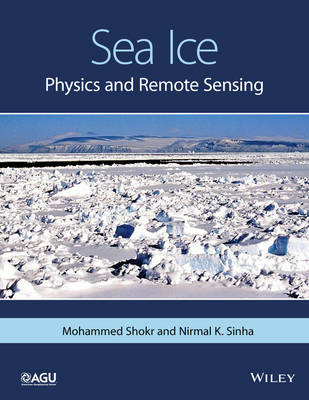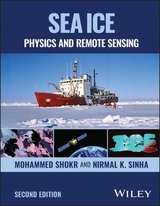
Sea Ice
American Geophysical Union (Verlag)
978-1-119-02789-8 (ISBN)
- Titel erscheint in neuer Auflage
- Artikel merken
Volume highlights include:
Detailed crystallographic classification of natural sea ice, the key information from which information about ice growth conditions can be inferred. Many examples are presented with material to support qualitative and quantitative interpretation of the data.
Methods developed for revealing microstructural characteristics of sea ice and performing forensic investigations.
Data sets on radiative properties and satellite observations of sea ice, its snow cover, and surrounding open water.
Methods of retrieval of ice surface features and geophysical parameters from remote sensing observations with a focus on critical issues such as the suitability of different sensors for different tasks and data synergism.
Sea Ice: Physics and Remote Sensing is intended for a variety of sea ice audiences interested in different aspects of ice related to physics, geophysics, remote sensing, operational monitoring, mechanics, and cryospheric sciences.
Mohammed Elsayed Shokr is a research scientist in Science and Technology Branch at Environment Canada. He is also affiliated with IEEE Geoscience and Remote Sensing Society (Institute of Electrical and Electronics Engineers) and the CASI Canadian Remote Sensing Society (Canadian Aeronautics and Space Institute). His research interests include studying sea ice physical and electrical properties which have greater implications in operational monitoring and climate studies. He also uses remote sensing techniques for sea ice modelling. Nirmal Sinha is an Engineer at the NRC Institute for Aerospace Research in Ottawa, Ontario. His research focuses on high temperature materials, like ceramics and advanced alloys that are used inside jet engines or gas turbine engines. This involves applying theories and experimental techniques about how snow and ice behaves around its melting point, to aerospace materials such as titanium-based and nickel-based 'superalloys'.
TABLE OF CONTENTS
AKNOWLEDGMENT
PREFACE
CHAPTER 1: INTRODUCTION
1.1 Background
1.2 Historical synopsis: Canada and the Arctic
1.3 The fascinating nature of sea ice
1.4 Sea ice in research and operational disciplines
1.4.1 Sea ice in marine navigation
1.4.2 Sea ice in physics
1.4.3 Sea ice in climatology
1.4.4 Sea ice in meteorology
1.4.5 Sea ice in oceanography
1.4.6 Sea ice in marine biology 1.4.7 1.4.7 Sea ice and offshore structures
1.4.8 Sea ice for Search & Rescue and transportation
1.5 Sea ice and remote sensing
1.6 About the book and its organization
CHAPTER 2: ICE PHYSICS AND PHYSICAL PROCESSES
2.1 Initial Ice Formation
2.1.1 Relevant sea water properties
2.1.2 Sea water freezing mechanism
2.1.3 Initial ice crystals and frazil ice
2.2 Ice Growth
2.2.1 Lateral ice growth
2.2.2 Vertical ice growth
2.2.3 Superimposed ice
2.2.4 Thermodynamic Ice growth
2.2.4.1 Modelling ice growth
2.2.4.2 Effect of Snow cover
2.2.4.3 Effect of oceanic heat flux
2.2.4.4 Effect of ice surface ablation
2.3 Inclusions in Ice
2.3.1 Compositional (constitutional) supercooling and brine pocket formation
2.3.2 Dentritic interface of sea ice
2.3.3 Salinity loss during ice growth
2.3.3.1 Initial rapid salt rejection at the ice-water interface
2.3.3.2 Subsequent slow salt rejection from the bulk ice
2.4 Ice Deformation
2.5 Ice Decay and Aging
2.6 Ice classes and regimes
2.6.1 Criteria of ice classification
2.6.2 Polynyas
2.6.3 Pancake ice regime
2.6.4 Ice edge and marginal ice zone
2.6.5 Ice of land origin
CHAPTER 3: SEA ICE PROPERTIES: DATA AND DERIVATIONS
3.1 Temperature profiles in ice and snow
3.2 Bulk salinity and salinity profile
3.3 Density of first-year and multi-year ice
3.4 Volume fraction of sea ice constituents
3.5 Thermal properties
3.5.1 Thermal conductivity of sea ice
3.5.2 Thermal conductivity of snow
3.5.3 Specific heat of sea ice
3.5.4 Latent heat of fusion
3.6 Dielectric properties
3.6.1 Dielectric constant of brine
3.6.2 Dielectric mixing models
3.6.3 Field measurements of dielectric constant
CHAPTER 4: POLYCRYSTALLINE ICE STRUCTURE
4.1 Terms and definitions relevant to polycrystalline ice
4.1.1 Special thermal state of natural ice
4.1.2 General terms for structural aspects of ice
4.1.3 Basic terms and definitions
4.2 Morphology of ice
4.2.1 Form of ice crystals
4.2.2 Miller Indices for hexagonal ice
4.2.3 Growth direction of ice crystals
4.2.4 Ice density in relation to crystalline structure
4.3 Structure- and Texture-based Classification of Natural Ice
4.3.1 Fresh-water ice classification of Michel and Ramseier
4.3.2 Extending crystallographic classification of fresh-water ice to sea ice
4.3.3 Crystallographic classes of natural ice
4.3.3.1 Granular or snow ice (T1 ice)
4.3.3.2 Randomly oriented (S4) and vertically oriented (S5) frazil ice
4.3.3.3 Columnar-grained with c-axis vertical (S1 ice)
4.3.3.4 Columnar-grained with c-axis horizontal and random (S2 ice)
4.3.3.5 Columnar-grained ice with c-axis horizontal and oriented (S3 ice)
4.3.3.6 Agglomerate ice with discontinuous columnar-grained (R ice type)
4.3.3.7 Ice of land-based origin
4.3.4 Stereographical projection (fabric diagram) of natural polycrystalline ice
4.4 Age-based structural features of natural sea ice
4.4.1 Young ice, Y (Sikuaq)
4.4.2 First-Year ice, FY (Siku)
4.4.3 Multi-Year ice, MY (Qavvaq)
4.5 Information contents in Polycrystalline Ice Structure
4.5.1 Geometric characteristics of crystalline structure
4.5.2 Geometric characteristics of brine pockets in first-year ice
4.5.3 Geometric characteristics of air bubbles
4.5.4 Biomass accumulation at the bottom of the ice
CHAPTER 5: AGING OF SEA ICE: STORIES THAT WERE NEVER TOLD
5. Mould Bay experiments: beginning of RADARSAT field project
5.1.1 Ageing in sea ice: transition from FY to MY ice
5.1.2 Ice conditions and parameters
5.1.3 Interface between Old and New ice in SY ice cover
5.1.4 Multi-year (MY) ice and interfaces: Mould Bay 1984 experience
5. 2 High-Arctic ice islands and microwave remote sensing experience
5.2.1 Background history of ice islands
5.2.2 Shelf ice and Arctic ice islands
5.2.3 Multi-Year rubble field of an Arctic ice island
5.2.4 RADARSAT images of Arctic ice islands
CHAPTER 6: LABORATORY TECHNIQUES FOR REVEALING STRUCTURE OF POLYCRYSTALLINE ICE
6.1 Relevant optical properties
6.1.1 Fundamentals of polarized light
6.1.2 Birefringence or double-refraction in ice (Ih)
6.1.3 Optical retardation
6.1.4 Interference colours for white light
6.2 Thin sectioning techniques for ice and snow
6.2.1 Hot- and Cold-plate technique for thin sectioning of ice
6.2.2 Double-microtoming technique (DMT) for thin sectioning of ice
6.2.3 Double-microtoming technique (DMT) for thin sectioning of snow
6.2.4 Precautions for thin sectioning by DMT
6.2.5 Optimum thickness for thin sections of ice and snow
6.3 Viewing and photographing ice thin sections
6.3.1 Laboratory and hand-held polariscope
6.3.2 Cross-polarized versus parallel-polarized light viewing
6.3.3 Scattered light and combined cross-polarized/scattered light viewing
6.3.4 Circularly polarized light and rapid crystallographic analysis
6.4 Etching techniques
6.4.1 Sublimation of ice and sublimation (Higuch)i etch pits
6.4.2 Etching processes and applications
6.4.3 Thermal etching of microtomed ice surfaces
6.4.4 Chemical etching and replicating ice surfaces
CHAPTER 7: REMOTE SENSING PRINCIPLES RELEVANT TO SE ICE
7.1 General Principles of satellite remote sensing
7.2 Historical synopsis of satellite remote sensing for sea ice
7.3 Electromagnetic wave properties and processes
7.3.1 Polarization and depolarization of EM wave
7.3.2 Reflection, transmission, absorption, scattering and emission
7.3.3 Brightness temperature and emissivity
7.3.4 Penetration depth
7.4 Optical sensing
7.5 Thermal infrared sensing
7.6 Microwave sensing
7.6.1 Passive microwave
7.6.2 Active microwave
7.6.2.1 Imaging radar principles
7.6.2.2 Multi-channel SAR
7.6.2.3 Radar polarimetry
7.7 Radiative processes in relevant media
7.7.1 Atmospheric influences
7.7.2 Sea water
7.7.3 Snow on sea: physical and radiative processes
7.7.3.1 Optical and thermal infrared regions
7.7.3.2 Microwave region
CHAPTER 8: DATA SETS OF RADIATVE MEASUREMENTS AND PROPERTIES
8.1 Radar backscatter
8.1.1 Backscatter databases from ice types and open water
8.1.2 Effect of wind-roughened ocean surface on backscatter
8.1.3 Multi-polarization data of sea ice
8.2 Microwave brightness temperature data
8.3 Visible and Near-Infrared reflectance and albedo
8.4 Emissivity data in the microwave region
8.5 Microwave penetration depth
CHAPTER 9: RETRIEVAL OF SEA ICE SURFACE INFORMATION
9.1 Surface deformation
9.2 Cracks and leads
9.3 Surface melt
9.4 Frost flowers
CHAPTER 10: RETRIEVAL OF ICE AND SNOW GEOPHYSICAL PARAMETERS
10.1 Ice type classification
10.1.1 Ice classification from optical and TIR systems
10.1.2 Ice classification from Microwave data
10.2 Ice concentration
10.2.1 Ice concentration from VIS and TIR images
10.2.2 Ice concentration from passive microwave observations
10.2.2.1 Description of selected algorithms
10.2.2.2 Sources of error and sensitivity of algorithms
10.2.2.3 Validation of ice concentration algorithms
10.2.2.4 Comparison of passive microwave algorithms
10.2.3 Ice concentration from SAR
10.3 Sea ice extent and area
10.4 Ice thickness
10.5 Ice Surface temperature
10.6 Snow depth over sea ice
10.7 Ice motion
CHAPTER 11: SEA ICE SERVICE IN CANADA: HISTORY AND CURRET OPERATIONAL PROGRAM
11.1 History of Ice Service in Canada
11.2 The operational sea ice programs and products
| Reihe/Serie | Geophysical Monograph Series |
|---|---|
| Verlagsort | Wasington |
| Sprache | englisch |
| Maße | 218 x 282 mm |
| Gewicht | 1746 g |
| Themenwelt | Naturwissenschaften ► Geowissenschaften ► Geologie |
| Naturwissenschaften ► Geowissenschaften ► Geophysik | |
| Naturwissenschaften ► Geowissenschaften ► Hydrologie / Ozeanografie | |
| Technik ► Elektrotechnik / Energietechnik | |
| ISBN-10 | 1-119-02789-6 / 1119027896 |
| ISBN-13 | 978-1-119-02789-8 / 9781119027898 |
| Zustand | Neuware |
| Haben Sie eine Frage zum Produkt? |
aus dem Bereich



